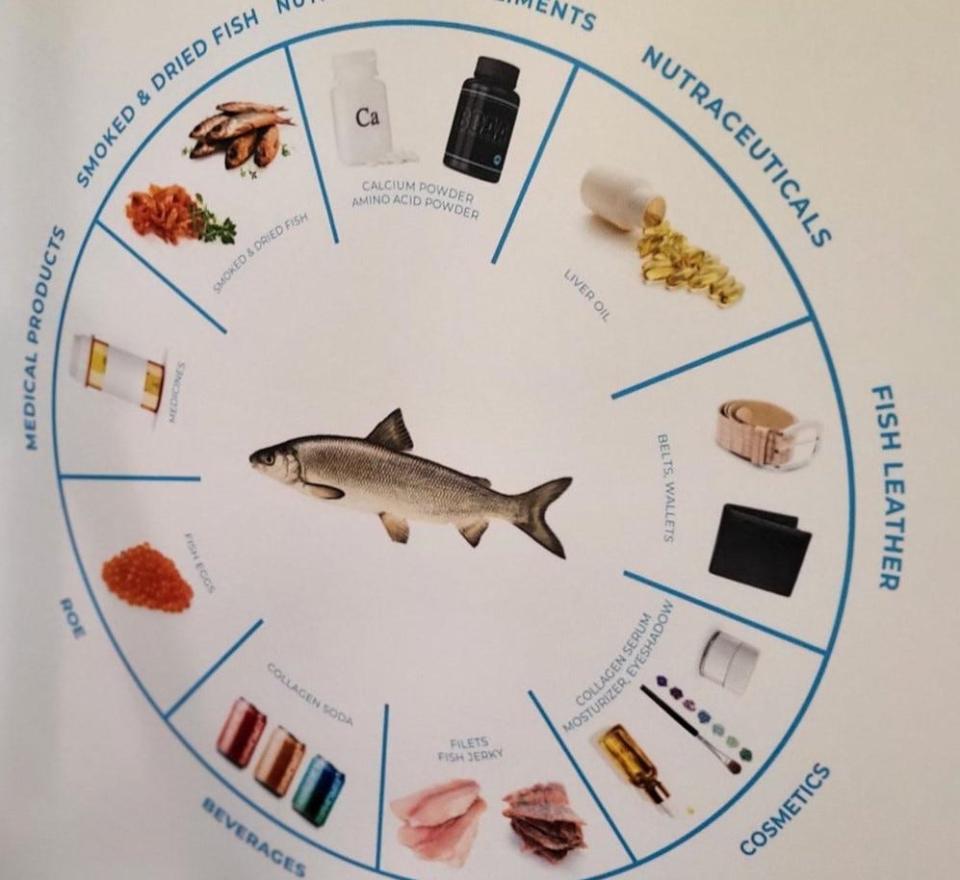Fish leather, dog treats: Door County fish companies pledge to use 100% of the fish they catch
DOOR COUNTY - Three Door County commercial fish companies are among 15 businesses that pledged to use 100% of every fish they catch on the Great Lakes by 2025, not only reducing waste but also potentially dramatically increasing the value of each fish.
J&M Fisheries and Henriksen Fisheries, both of Ellison Bay, and Baileys Harbor Fish Company recently signed the “100% Great Lakes Fish Pledge,” a first-of-its-kind effort asking fisheries on the Great Lakes in the U.S. and Canada to commit to using every bit of their commercially caught fish.

The pledge is part of the 100% Great Lakes Fish initiative created by the Conference of Great Lakes St. Lawrence Governors & Premiers, an organization representing the governors of the Great Lakes states and the premiers of the Canadian provinces of Ontario and Québec.
A news release from the organization said the companies that signed the pledge will explore and implement innovative applications for fish by-products, such as protein, marine collagen, fertilizer, leather and other new, high-value products. The idea is to prevent waste and promote the sustainable use of Great Lakes fish.
"We have been talking with David Naftzger (executive director of GSGP) since last winter and we are very interested in this project," Charlie Henriksen, co-owner of Henriksen Fisheries, said in an email to the Door County Advocate about why his company signed. "We are also conservationists who have a large interest in the sustainability of commercial fishing and are always interested in ways to improve and diversify."
The news release noted that most of a commercially caught fish that's used mostly as a food source isn't used to its maximum, or to its best value. It said about 40% of those fish are made into fillets and eaten, while the remaining 60% usually just becomes inexpensive animal feed or gets discarded.
The effort builds on a successful experience with cod fisheries in Iceland and other species elsewhere globally. Iceland pioneered the 100% fish strategy, and under their program, the use of an Icelandic cod’s biomass has increased from 40% (almost exclusively fillets) to more than 90%, with the non-eaten parts, skin and all, processed into a variety of food and non-food products.
"More products in different markets will increase awareness of the whitefish and commercial fishing industry harvesting the fish," Carin Stuth, co-owner of Baileys Harbor Fish, said to the Advocate. "Responsible commercial fishing is very important in the global seafood market. Using the protein for food and then converting the by-products into other things is a great use of the natural resource."
Besides reducing waste, the use of the fish by-products after filleting also raises the value of each fish, the news release said. It cited initial studies in the U.S. that determined the value of a whitefish could jump from $12 when used only for fillets to nearly $4,000 when 100% is used, depending on its use.
Stuth said Baileys Harbor Fish currently is equipped to sell fish by-products to other companies, such as collecting the entrails, scales, bones and heads for fish fertilizer. She said their company specializes in fish as food, selling to wholesale markets and direct to consumers at their shop, so she envisions supplying entrepreneurs who can make use of the fish by-products.
"I believe the concept of using all the whitefish by-products is wonderful," Stuth said. "We are definitely a resource for entrepreneurs who want to launch new products using the by-products from whitefish processing."
Henriksen said his fishery already is using much of its harvested fish. It works with a company to make fertilizer from much of their waste product and is working with Prof. Dong-Fang Deng at the University of Wisconsin-Milwaukee School of Freshwater Sciences to use some waste for aquaculture feed. Other by-products are used to make dog treats (GemmaLous Furbaby products) and fish sausage, he said.
With this new effort, Henriksen said his fishery will work with Fiskur Leather, a Minnesota-based company, and local artisans to make fish leather products such as belts, bracelets, bookmarks, wallets and earrings.
"Anything positive happening always benefits the entire industry," Henriksen said. "It appears that this will be a long-term project and the logistics of some of it will be daunting, but there are good parts happening already."
For more information on the 100% Great Lakes Fish project, including a copy of the pledge, visit gsgp.org.
Contact Christopher Clough at 920-562-8900 or cclough@doorcountyadvocate.com.
MORE: Sturgeon Bay, Ellison Bay play host to two art crawls this weekend
MORE: Study shows how much the arts matter to Door County's economy and pride. Hint: It's a lot
FOR MORE DOOR COUNTY NEWS: Check out our website
This article originally appeared on Green Bay Press-Gazette: Door County fish companies pledge to use 100% of the fish they catch

